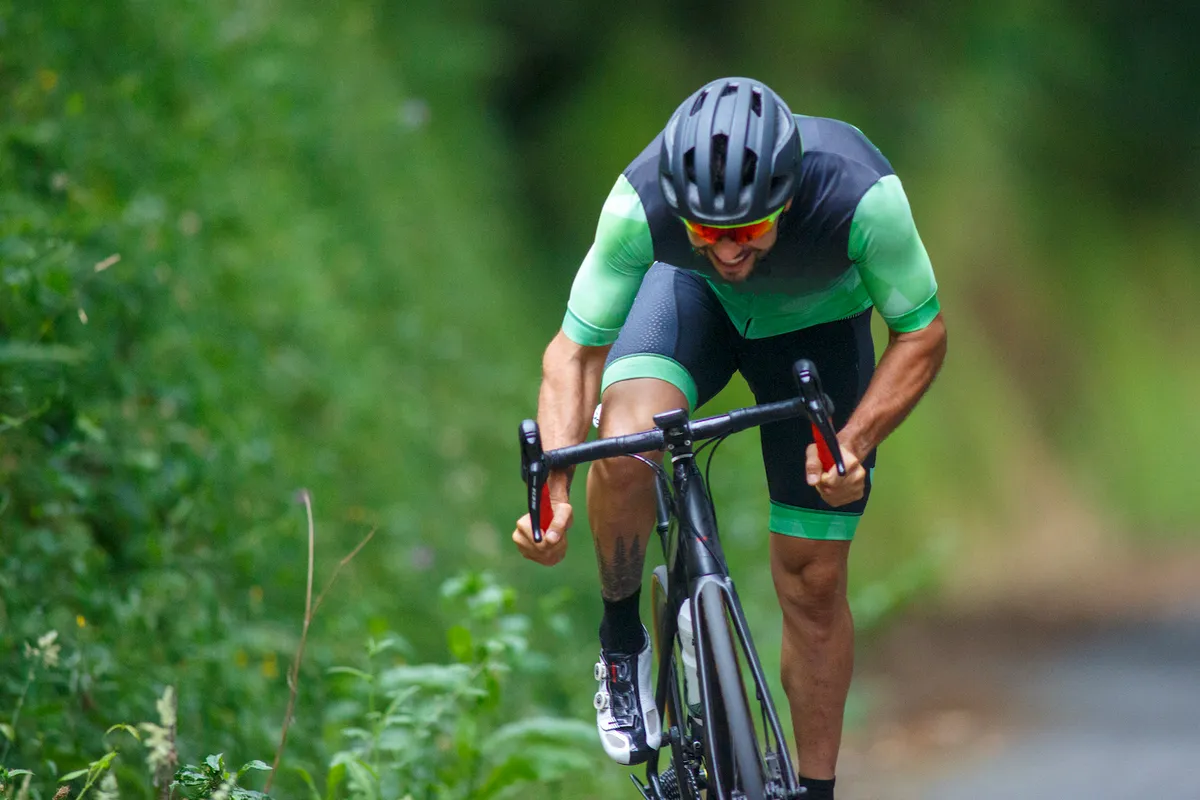Before choosing the right bike for you and weighing up the pros and cons of road and triathlon bikes you need to analyse your technical riding ability (pedalling, cornering, general handling), their bike set-up (racing position), training time and fitness.
Such factors actually determine what the pros and cons of differing bikes are for different people.
I’d suggest that newcomers and time-constrained triathletes who are aiming to improve cycling technique would benefit most from using road bikes; those athletes with time to ride for more than six hours a week could benefit from using both. Here’s why…
Triathlon bikes
A triathlon bike comprises a frame that’s often streamlined into an aerodynamic shape, with large flat or oval tubes designed to cut through the air and reduce the frontal area.
Making up the ‘diamond’ shape of the frame, these tubes are generally set at steeper angles than a road bike, so that the more upright seat tube has the effect of bringing the rider further forward over the bottom bracket.
This, in theory, allows the triathlete to reduce some of the cycling impact on what would normally be stretched-out quadriceps, in better preparation for the run phase.
On a triathlon bike, the steering column is usually steeper, giving a stiffer feel to the front of the bike and making it more responsive with out-of-the-saddle surges and around corners.
This also has the effect, together with an often-tighter rear triangle, of creating a shorter wheelbase than a traditional road bike.

Because of this, the ride or ‘feel’ of a tri bike can be much stiffer, with bumps on the road surface felt in the crotch, lower back, arms and shoulders of the rider.
Apart from standard groupset parts such as brake calipers, chainset, front and rear mech, and stem, which are also common on a road bike, other components on a tri bike include a set of fixed aerobars, lightweight brake levers and bar-end gear shifters.
These allow the rider only one hand and arm placement and, therefore, one riding position.
Consequently, it’s very difficult to use this sort of bike for easy, relaxed recovery-type rides and hilly riding where constant position and gear changes are a must for efficiency and comfort.
Because of this, it’s an all-out racing machine for mainly flat, shorter courses, while the wheels would normally be deep-section front and rear or a disc on the rear to further the aero benefit of riding on your own.
- The best triathlon bikes reviewed
- Is a road bike or triathlon bike better for descending?
- Women's guide to buying a triathlon bike
Road bikes
Road bikes are often less job-specific than a tri bike with its aerodynamic, speed and run-adaptability focus.
A road bike balances lightness, stiffness, handling and comfort, with just a little focus on aerodynamics thrown in.
This is because they’re designed to perform well over a multitude of surfaces: for short sprints of a few seconds or long slogs over several hours; on tight courses with many corners or long straights; against buffeting winds; in close contact within bunches of other riders; or on lone rides.
A road bike generally has shallower tube angles that forge the frame shape, which positions the rider further behind the bottom bracket for an optimum cycling position that, together with a longer wheelbase, softens the feel of the road surface.
Road bike frame tubes are constructed with cushioning and vibration reduction for improved comfort.

For example, top tubes are often made with thicker sides than the tops and bottoms to dampen vibrations while retaining stiffness for proficient energy transfer.
The main component benefit with road bikes is that they feature dropped racing handlebars.
This gives numerous hand and arm positions for comfort and adaptability for any variety of riding you wish to practise, which is ideal for perfecting your riding technique.
When you’re efficient with the basic road set-up, you can move to aerobars by simply adding a pair of inexpensive ‘clip-ons’ to your road bike, allowing you to go even faster in the correct ‘tucked’ position.
Wheels can be exactly the same as on a tri bike – and often easier to remove and replace because of the longer wheelbase.
Making the change
If you’re proficient at riding the bike you have, whether it’s a triathlon bike or a road bike, then either will serve you well.
If you’ve got poor position, aren’t proficient at bike handling or struggle with bike fitness, then neither bike type is perfect for you yet.
You should focus on addressing these issues, and using a road bike here is likely to help you out the most.
Bike-handling ability issues can only be addressed out on the road. Basic skills include efficient straight-line riding; riding tucked down low, in the saddle, out of the saddle; accelerating out of corners; pedalling style; correct gear choice; cornering; braking; eating/drinking efficiently on the move; and climbing and descending.
These are only going to be perfected on a road bike and if you can ride with a group your riding proficiency is likely to be fast tracked even more.
Fitness is something best achieved through time spent on the bike and again riding in a group, on a road bike, at faster speeds will improve fitness levels further.
Beyond this, use a tri bike if you think it’ll improve your triathlon performance further.
But make sure that your set-up and technical ability gives you the aerodynamic benefit of the extra expense, otherwise you could find yourself disappointed at not going any faster compared to your road bike performances.
Ironman athletes in particular need to be comfortable riding for many hours down in a tuck, and this can only come by practising for many hours in that position. Otherwise, backache and a reduced performance on the day are inevitable.
Top image credit: Edwin Tan
